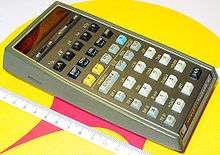HP-65
 The HP-65 | |
| Type | Programmable |
|---|---|
| Introduced | 1974 |
| Calculator | |
| Entry mode | RPN key stroke |
| Display type | 7-segment red LED |
| Display size | 10 digits |
| CPU | |
| Processor | proprietary |
| Programming | |
| Programming language(s) | key codes |
| Memory register | 8 (9) plus 4-level working stack |
| Program steps | 100 |
| Other | |
| Power supply | charger 115/230 V, 5 W |
| Weight | 312 g including battery pack |
| Dimensions | 14.7 cm × 8.1 cm × 3.4 cm (1.8 cm on thin side) |

The HP-65 is the first magnetic card-programmable handheld calculator. Introduced by Hewlett-Packard in 1974 at an MSRP of $795,[1] it featured nine storage registers and room for 100 keystroke instructions. It also included a magnetic card reader/writer to save and load programs. Like all Hewlett-Packard calculators of the era and most since, the HP-65 used Reverse Polish Notation (RPN) and a four-level automatic operand stack.
Bill Hewlett's design requirement was that the calculator should fit in his shirt pocket. That is one reason for the tapered depth of the calculator. The magnetic program cards are fed in at the thick end of the calculator under the LED display. The documentation for the programs in the calculator is very complete, including algorithms for hundreds of applications, including the solutions of differential equations, stock price estimation, statistics, and so forth.
Features
The HP-65 introduced the "tall", trapezoid-shaped keys that would become iconic for many generations of HP calculators. Each of the keys had up to 4 functions. In addition to the "normal function" printed on the key's face, a "gold" function printed on the case above the key and a "blue" function printed on the slanted front surface of the key were accessed by pushing the gold "f" and blue "g" prefix key, respectively. For example, "f" followed by "4" would access the sine function, "g" followed by "4" would calculate 1/x. For some mathematical functions, a gold "f −1" prefix key would access the inverse of the gold-printed functions, e.g. "f −1" followed by "4" would calculate the inverse sine (sin−1).
Functions included square root, inverse, trigonometric (sine, cosine, tangent and their inverses), exponentiation, logarithms and factorial. The HP-65 was one of the first calculators to include a base conversion function, although it only supported octal (base 8) conversion. It could also perform conversions between degrees/minutes/seconds and decimal degree values, as well as polar/cartesian coordinate conversion.
Programming

The HP-65 had a program memory for up to 100 instructions of 6 bits which included subroutine calls and conditional branching based on comparison of x and y registers. Some but not all commands entered as multiple keystrokes were stored in a single program memory cell. When displaying a program, the key codes were shown without line numbers.
A program could be saved to mylar-based magnetically coated cards (71 mm × 9.5 mm), which were fed through the reader by a small electric motor through a worm gear and rubber roller at a speed of 6 cm/s.[2] The recording area used only half of the width of the card. While reversing the card to store a second program was possible, it was officially discouraged (unlike in later models such as the HP-67) because the other half of the card was touched by the rubber wheel during transport, causing extra abrasion. When inserted into an extra slot between the display and the keyboard, the printing on top of the card would correspond to the top row of keys (A - E), which served as shortcuts to the corresponding program entry points.
Cards could be write-protected by diagonally clipping the top left corner of the card. HP also sold a number of program collections for scientific and engineering applications on sets of pre-recorded (and write-protected) cards.
The HP-65 had a "feature" whereby storage register R9 was corrupted whenever the user (or program) executed trigonometric functions or performed comparison tests; this kind of issue was common in many early calculators, caused by a lack of memory due to cost, power, and/or size considerations. Since the limitation was documented in the manual, it is not strictly speaking a bug.
Significant applications
During the 1975 Apollo-Soyuz Test Project, the HP-65 became the first programmable handheld calculator in outer space. It was carried as a backup in case of a problem with the Apollo Guidance Computer. It was not put into operation, though, as the Apollo computer did not malfunction during that mission.
Also in 1975, Mitchell Feigenbaum, using the small HP-65 calculator he had been issued at the Los Alamos National Laboratory, discovered that the ratio of the difference between the values at which successive period-doubling bifurcations occur tends to a constant of around 4.6692... This "ratio of convergence" is now known as the first Feigenbaum constant.

See also
References
- ↑ "HP Virtual Museum: Hewlett-Packard-65 programmable pocket calculator, 1974". Retrieved 2011-01-29. US$795 in 1974 ≈ US$3,420 in 2009 (see The Inflation Calculator)
- ↑ Robert B. Taggart, Designing a Tiny Magnetic Card Reader. Hewlett-Packard Journal, May 1974. http://www.hpl.hp.com/hpjournal/pdfs/IssuePDFs/1974-05.pdf
External links
- The HP-65 at an unofficial Hewlett-Packard museum (MyCalcDB); includes a photograph of the magnetic card.
- 1975 HP Calculator Christmas Guide
- HP's Virtual Museum: HP-65
- HP-65 page at the unofficial Museum of HP Calculators